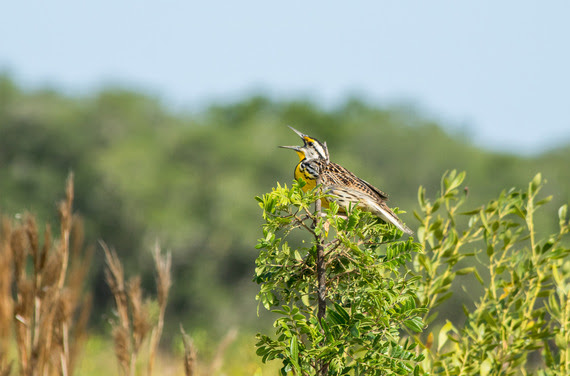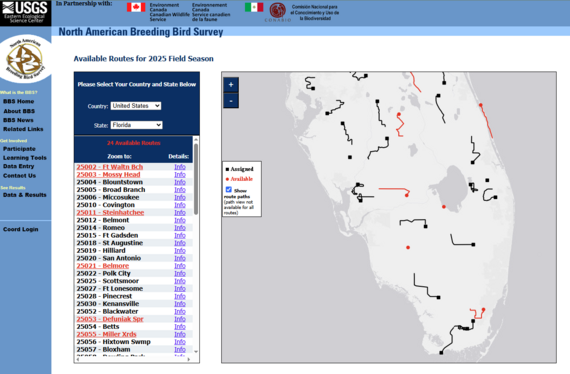 Eastern Meadowlark, photo by FWC. In Florida, these birds most commonly breed in the open pastures and prairies of the peninsula. The North American Breeding Bird Survey is a long-term, large-scale international bird monitoring program launched in 1966 to track the health and trends of bird populations across North America. Jointly coordinated by the United States Geological Survey Eastern Ecological Science Center and Environment Canada's Canadian Wildlife Service, the survey runs annually in the U.S., Canada, and Mexico. Kite Tales spoke with Simon Fitzwilliam, Avian Research Biologist at the Florida Fish and Wildlife Conservation Commission and state Breeding Bird Survey coordinator, to learn about the survey in Florida. What is the Breeding Bird Survey? The Breeding Bird Survey is an annual bird monitoring effort that takes place during the breeding season, which in Florida generally runs from May to June. The survey provides crucial data that tells researchers and wildlife managers when there are significant changes in bird populations. This information helps them address declines and prevent populations from reaching critically low levels. How is the survey conducted? Florida has 81 active survey routes. Surveys are conducted along assigned driving routes and each route gets surveyed by its assigned observer once per year. At designated locations along the route the observer safely pulls over every half mile, exits their vehicle, and records every bird they hear and see in a three-minute window. Routes are approximately 25 miles long with 50 stops each. The surveys start 30 minutes before sunrise and can go no later than five hours after sunrise, which makes for a pretty busy morning. Every observer is provided with a survey protocol and online training. The protocol is quite detailed, and the surveys need to be conducted in calm weather. This rigorous protocol has helped the survey maintain its accuracy and relevance over more than six decades of data collection. The survey methods have remained the same since the start of the survey in the 1960s, so all information is provided as paper hard copies, although observers now have the option to send their results electronically as well. What kinds of birds are recorded? The number of bird species observed during the survey can vary depending on the location, but generally, 30 to 70 species may be recorded along a given route. These species include both common and rare birds, with the list of potential species being drawn from all birds documented on the survey routes since 1966. To prepare for the task, observers can visit the Breeding Bird Survey website to access lists of birds that could be encountered during their survey. What is expected from volunteers in terms of birding skill level and commitment? Participants in the Breeding Bird Survey need to be able to recognize all the local birds both by sound and sight, as bird identification plays a central role in the survey. Listening for bird calls is the primary means of identification, so having good hearing is critical. While the survey doesn’t test birding abilities, volunteers are expected to be familiar with the birds they might encounter along their route. If participants are unsure of their abilities, they are encouraged to review the bird list beforehand and ensure they are confident in their identification skills. Additionally, participants should prepare for the survey by familiarizing themselves with their designated route ahead of time. This extra effort is appreciated and helps the survey morning run more smoothly. However, participants should also be aware that the original survey protocol has remained largely unchanged since 1966 and does not incorporate modern tools like GPS. Some participants may even go above and beyond, creating their own maps or reviewing route descriptions to ensure they are fully prepared and to enhance their experience. How long is the commitment for participating in the Breeding Bird Survey? When you sign up to participate in the Breeding Bird Survey, you are automatically committed to a three-year period. While participants can opt out at any time, they must actively choose to do so. This long-term commitment helps ensure consistency in data collection over multiple years. How do participants find available routes? To find available routes, participants can visit the Breeding Bird Survey website and navigate to the section for vacant routes. On the site they can view an interactive map that shows the routes that have not yet been assigned. While routes near population centers tend to fill up quickly, there are still many more remote routes in need of volunteers. By zooming in on the map, participants can see the specific route paths and gain access to more detailed information.  Breeding Bird Survey routes in south Florida, as seen on the survey website. How can participants get involved? For those interested in participating, the Breeding Bird Survey website provides resources, including bird identification quizzes and an overview of the survey’s goals. It’s important for potential participants to explore the site and familiarize themselves with the process before reaching out to the state coordinators. How can newer birders who are interested in the Breeding Bird Survey improve their skills enough to participate? One of the best ways to improve your skills is to go birding with more experienced birders and learn from them. Get lots of practice birding by ear, increasing your familiarity with local bird calls and sound identification. The Learning Tools on the Breeding Bird Survey website are a great resource. They include a reference tool for visual and sound ID, narrative descriptions of identifying features, and a quiz based on summer and winter distribution maps. | 
No comments:
Post a Comment